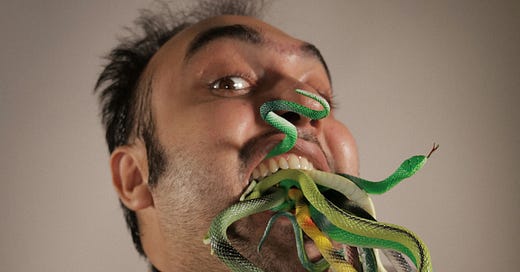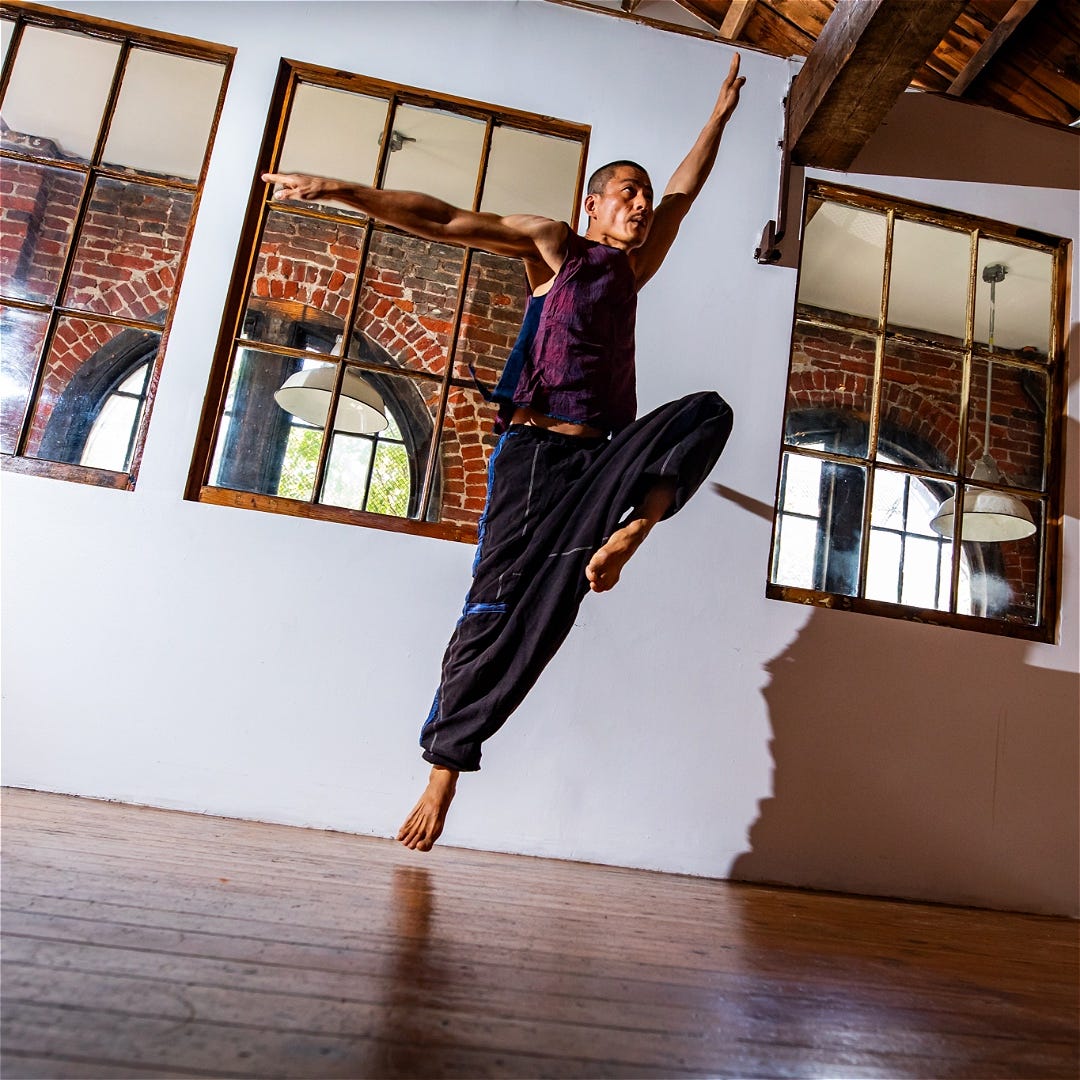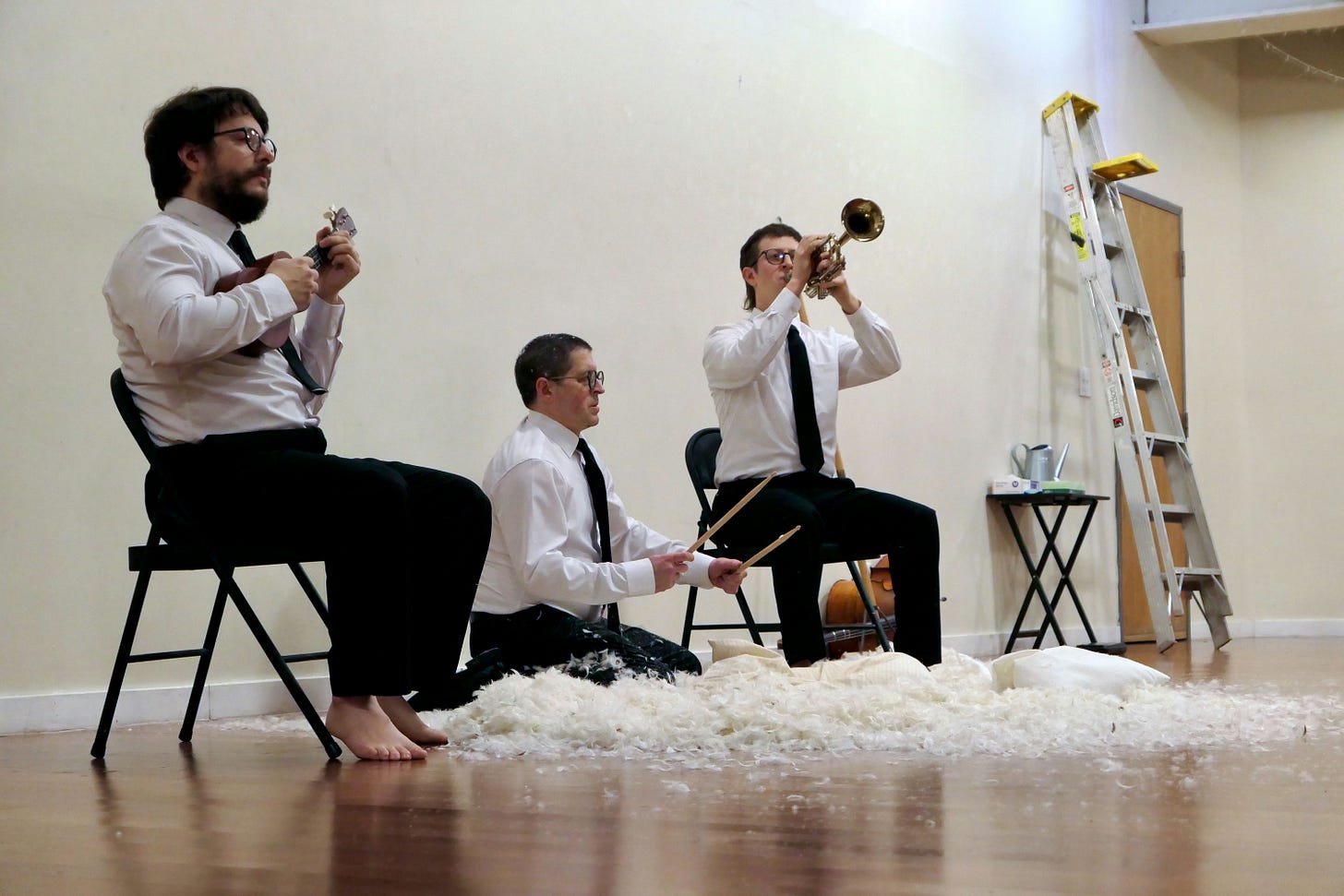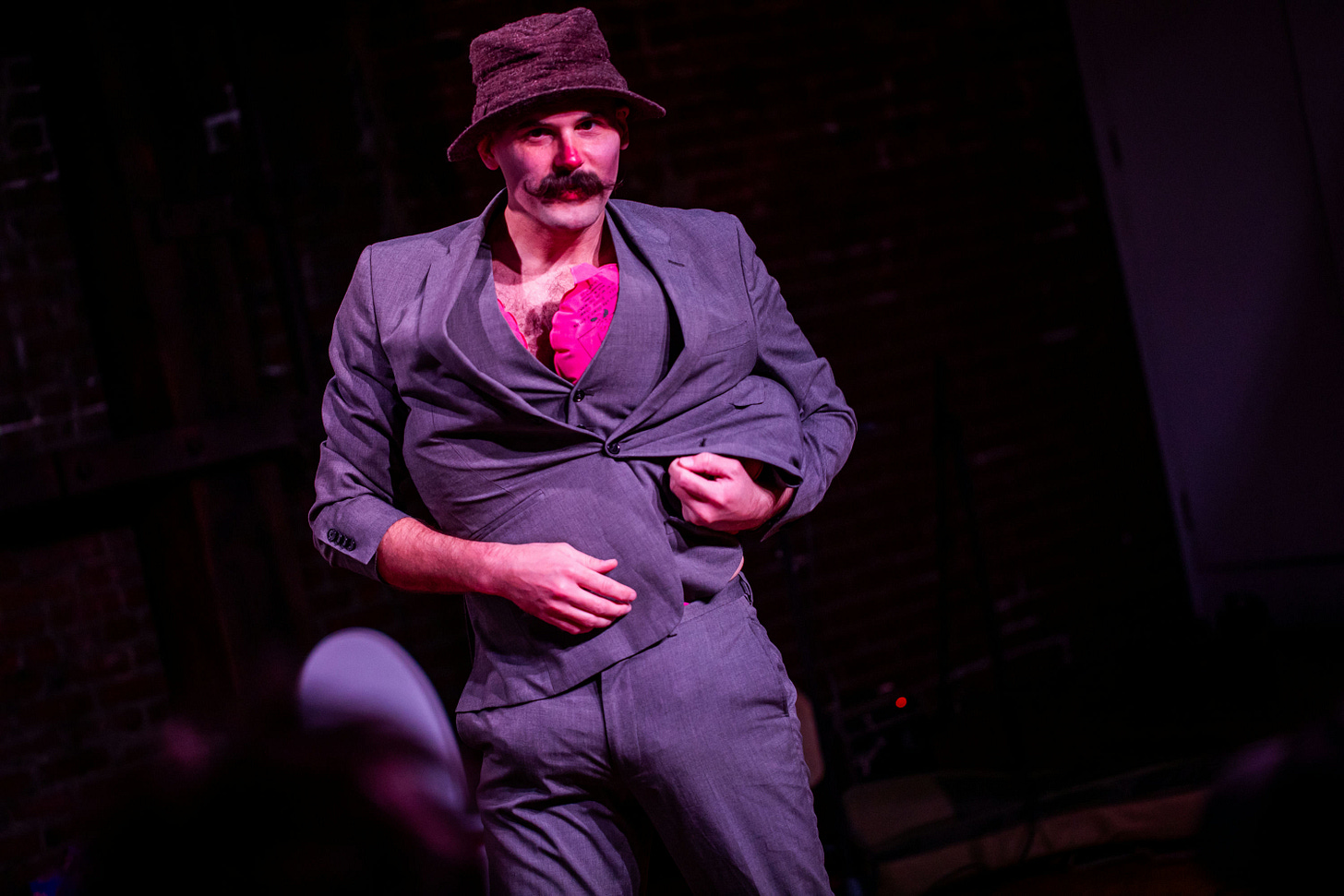Seven Philly Fringe shows: Sohrab is Bumbling Foriegner, Phone Claw for Mister, Holland Andrews
The Fluxus Brothers Present: Good Art Bad Art, Jungwoong Kim's within/without, MK + A rewatch podcast, and Jeff Evans's SHITTER: Take Deuce
Back in January, I wrote about how The Wilma’s was hiring an “associate producer,” a new position replacing the departing “artistic associate & literary manager,” which was already two jobs that had been rolled into one. Not only did this posting formally eliminate the literary department, it was also underpaid, hiring at either 40k or the “low 40’s” and with a requisite 5 years experience. I bring it up now because Nell Bang-Jensen, incoming producing director at FringeArts, started her professional career in the theater as The Wilma’s artistic associate.
If you pay close attention, you can see the ladder being pulled up in real time.
One thing that I’m dissatisfied with in my own work here is that the fast-turn around demanded not only by this format, but especially by the fast movement of the Fringe, is that I can’t engage deeply with everything. Nor can I edit and rewrite up to the standard I would normally like to present, even within the “I’m doing this for free and it is a productive diversion” category. Some of this is rushed. But it’s also free, so you’re not allowed to get mad when I make mistakes. That said, please click the buttion:
Sohrab is Bumbling Foriegner
by Sohrab Haghverdi
created with and co-directed by Benjamin Rosenthal and Mason Rosenthal
Continues September 21 and 28 at Christ Church Neighborhood House
Highly Recommended, with a rather strong content advisory about piss.
An inventive and often outrageous piece of clowning about art, immigration, and identity which makes the border tangible in maybe the most disgusting possible way.
With a fanfare, a man in the audience stands up, takes the stage, and introduces himself. But it’s not Sohrab Haghverdi, it’s Philipe AbiYouness, program coordinator from Al-Bustan Seeds of Culture, who have partnered with the Cannonball Festival on a programming track and award for artists of Southwest Asian and North African descent. AbiYouness tells us Sohrab is working in the tradition of hakawati (Arabic for “storyteller”), except Sohrab is like, “a Hakawati with his head chopped off.”
Sohrab enters and crawls around the stage, coughing, sweating. He’s wearing a wool sport coat several sizes too small and white bell-bottoms. His shirt is unbuttoned far enough to reveal plenty of chest hair and show off a gold chain. He crawls in circles. He spits into a gallon jug labeled, “SPIT.” Eventually, he gets up and speaks. “That was my grandfather.”
He tells us he used to be a linear storyteller, and because of that, his work was eventually dismissed. He tells us he got crazy, but that that, too, eventually led to his work being dismissed. He tells us we will not understand the rest of the performance, and offers us a series of increasingly absurd explanatory “keys” by which we may understand and, yes, “unlock” the meaning to the performance, such as story, metaphor, spiritual curse, and film noir. By the time we get to the final key, we’re maybe more than halfway into the show, which keeps reframing itself.
Sohrab has retrograde ejaculation. Sohrab misuses words. Sohrab has a suitcase full of toy pigs. Sohrab has three suitcases full of balls. The suitcases are “very middle eastern,” AbiYouness tells us, in an awkward interruption that structures the piece. Sohrab has a giant testicle. Haghverdi confronts us with the most abject parts of his biography, refracting and amplifying them so they are both absurd and existential at once. Bumbling Foriegner is always playing with the distance between Haghverdi himself, his work, the audience, stereotypes, and what’s real and what’s not, as it rails against the racism of the art world and the US immigration system. It makes the connection between these two systems real.
On opening night, I thought the show was missing a touch of something, not uncommon in new works like this, and there’s good odds it’ll find whatever that thing was on the successive nights, or in whatever the next iteration of this work is. It’s possible that it won’t, that it’s tied to Fringe-related production value, and to the challenges of the space, such as the extraordinary depth of the Neighborhood House stage. But the ideas and the performance are all here, except perhaps for the show’s ultimate challenge, made more difficult by sweating in a wool jacket under stage lights for an hour.
Unconventional. Undissmissable. Unforgettable.
within/without
by Jungwoong Kim
with Germaine Ingram
Continues Sept 22
Not Recommended, with redeeming qualities—your experience as a dance fan may vary.
I feel somewhat unqualified to make any sort of recommendation here, this is out of my ballpark and also, well, I got pretty bored at times. Maybe a pacing problem, this moves pretty slow throughout but is also very charming at times. Kim and Ingram are both talented movers, but I wasn’t consistently connected with them. A solo, a duet, and a conversation. Ingram occasionally shares with us anecdotes from her life where dance and music are keys. She tells us a touching story of Kim’s relationship to traditional Korean music. Sound, music and rhythm as memory, comfort and home. Music is all provided by cassettes on players of various sizes throughout the stage. There’s an audience participation bit which didn’t work, in no small part because the rules of participation were unclear, and I think more production value in lighting design would have helped a lot. I’m curious where this would go with more development.
The Fluxus Brothers Present: Good Art Bad Art
by Morgan FitzPatrick Andrews, Mason Rosenthal and Benjamin Rosenthal
Continuing September 27
Recommended, with a couple qualifications
A lecture/demonstration on Fluxus, the avant-garde art movement of the 60s and 70s, at its strongest when it's performing famous pieces or recontextualizing them as theater, but ends on a pretentious note.
After setting the tone by “performing” the “Cannonball pre-show speech” as a performance art script, Dada (Morgan Andrews) in black slacks, a white shirt, and suspenders, then introduces the Fluxus Brothers #1 (Mason Rosenthal) and Number #2 (Benjamin Rosenthal). Dada has stopped up Brother #1’s trumpet with bubble gum so he can’t ruin John Cage’s 4’33”, the composers (in)famous piece where a musician plays nothing for four minutes and thirty three seconds. After contributing to the popular misunderstanding that 4’33” is about the audience listening to itself, rather than the audience listening to everything, it turns out they’ve decided not to do that piece, after all, and proceed to move through a laundry list of often famous Fluxus and conceptual art performance scripts.
This is performance art recontextualized as theater, performed by two clowns and their leader. The Brothers, in matching outfits, do not speak, except for Brother #2’s own original performance script, Bang, which consists solely of pointing finger guns at the audience and shouting “Bang” over and over and over again. Of this, in a tape cassette Dada plays explaining the work, Brother #2 says, “it’s good that it goes on too long.” I’m not sure if I agree (mostly I kept thinking about Alan Resnick’s One Funny Hour, which performed at PhilaMoca last month and featured a very effective finger-gun bit. I should probably write about that.), but the length does do something, turning it absurd. The cassette recording is interesting but also goes only a little too long.
More effective is all of Dada’s text, where he often speaks for the Brothers. Their conflicting points of view are often a humorous contrast, and the metatheater of Brother #1’s insistence that Dada include parts of his own story, which he doesn’t want to do, to add emotional stakes to the piece is a great bit. Andrews isn't an especially strong performer here, shuffling his feet through his longer speeches. There were times that I felt like if I got up, I could push the Rosenthals over with an easy shove. But these aren’t really problems here, the show doesn’t rely on that kind of presence.
Good Art Bad Art is a fun time, but ultimately a touch self-satisfied and pretentious. The Fluxus Brothers might answer that that’s the point, this question of good art and bad art which the show is constantly asking along with does it matter?1 The brothers dare to bore us when they bring the show to a close with 4’33”: mission accomplished. It’s as if they’ve forgotten what they’ve just done for the last fifty minutes and are trying, at the last, to stake out a claim that it’s more art happening than comedy, that this is, in fact, serious stuff. The Fluxus Brothers’ and Dada’s ambitions here do not match their form: the thesis they present for most of the show is that art is, in fact, not so serious.
SHITTER: Take Deuce
by Jeff Evans
Not recommended
Nonsense with whoopee cushions and orange tennis balls, plus video that seems unrelated and a poop-podcast read from the page while facing away from us. Evans has a certain physical strength as a performer, but also kept cracking up. So did some of the audience, but I didn't get the joke. Adds up to the sum of its parts, which is not much.
MK + A Rewatch Podcast
by Morgan McKenzie Kauffman
directed by and devised with Marisol Soledad
Recommended, with some qualifications
A 90s nostalgia trip that sits with the existential angst of child stardom and growing up into cultural irrelevance.
Structured around MK + A (both played by Kauffman, and all but explicit stand-ins for the Olsen twins) doing a rewatch of their childhood body of work, starting with Full House, Season 4, Episode 1, “Greek Week” (airdate: September 21, 1990), MK + A alternates between static scenes of recording and energetic bursts of physical theater. Kauffman recreates Olsen twin music video choreography, uncomfortable talk show appearances, and dons coveralls to excavate 90’s culture, somewhere between an archaeologist and a thief.
This show has a couple weak spots, but the show isn’t long enough for it to wear outs its welcome. One of them is being a solo show about twins, and representing one of the twins through projected video. Using the house projection screen installed to the left of the space, it can dominate over the podcast setup. But the video isn't just there for nothing, it eventually degrades as the show slides toward horror. Another is the speed of quick changes, limited both by what technically needs to happen during them and being a solo fringe show, but given the constraints, they’re admirably and atmospherically covered.
There’s something in the dramaturgy that’s missing, and I think that may be from bumping into the constraints, ethical and otherwise, of using someone else’s real story, someone else’s childhood, as material. I wonder if a level of fictionalization would elevate the work, it would allow it to go to more places, but much of the strength of MK + A comes from the pulled-from-real-life truth of its material, down to the verisimilitude of Kauffman’s dancing. Kauffman pulls off some impressive tricks with lighting, wigs, costumes, and VHS tape. A solid festival entry.
Phone Claw for Mister
mimebaby theatre
created and performed by Rose Weiss, MK Korbisch, and Heather Hosford
Recommended
Madcap physical theater with infectious energy, the mimebaby troupe looks like they’re having almost too much fun throughout.

Michelle Thornton, Michelle Wilder, and Michelle Michelle work together in a call center. Here’s a set of clowns as low level lackeys in a corporate world and worshiping Jupiter, you know, the Roman god, for some reason—and something to do with claws. It doesn’t always make sense, but it seems internally coherent. Are these people in a Jupiter cult, or is it their job that’s a cult, or is it both, and does it matter?
Somewhere in the audience Train’s “Drops of Jupiter” plays. It’s the ringtone for the titular phone call, ”everyone is or knows a mister.” The phone is in a sock. The theater-goer who answers the fake call is addressed as Captain. Somebody is talking about cheddar biscuits. Hints of darkness appear, references to workplace injuries and crashes amongst wordplay, malapropisms and creative misspellings. Michelle Michelle (Rose Weiss) is the banana man to Thornton and Wilder’s straight man, but nothing is straightforward or deadpan here. We have to choose—but what for?
If I was meant to walk away from the show with deeper feelings and reflections, it didn’t quite get me there, but I had a lot of fun. The show’s quiet, intimate, and slightly sinister (preceded, as it was, by something much more sinister) ending didn’t impact me emotionally, though the moment works. Phone Claw for Mister is absurd dance theater that captures some of the absurdity and inanity of our times.
Holland Andrews
at Solar Myth, co-presented by FringeArts and Ars Nova Workshop
performing again tonight, September 20, at 8
Highly recommended. Fans of contemporary music will not be disappointed.
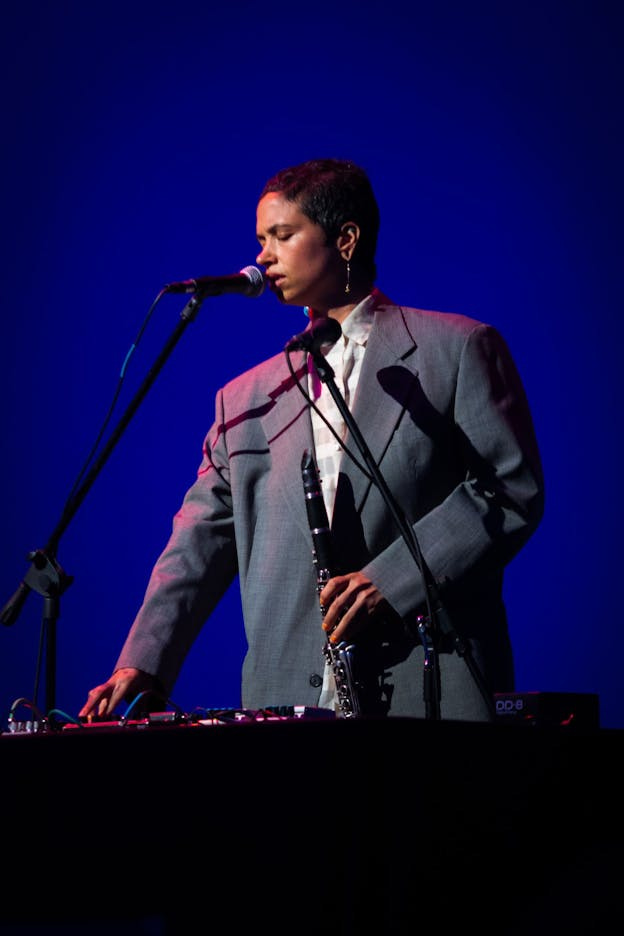
The first of a two-night stand, the evening was “messing around with old material” and primarily was two long numbers. Operatic, noisy, layered, haunting, Andrews plays clarinet, electronics, and sings with a significant amount of extended technique. “My doubts are getting in my way,” reverberating, repeating, but not in their way tonight. Hard to beat the cozy back room at Solar Myth, which not only sounds great, but has a great bar up front. If this was just messing around, tonight’s performance is sure to be great.
There’s one show I saw this week, which is closed now and I haven’t written about here. I’m saving that one for later. Things on my agenda for this weekend include Love you Love you Love You, Othello (vs The Military Industrial Complex), and Bodhisattva Beer Run, while I’m experiencing fomo, or at least curiosity about, over PINCH, Disaster Theater and All Quiet on the Western Front.
There’s simply too much to see, it’s not possible, especially if your interests stretch across multiple genres. It’s certainly not possible to write about it all, and I’ve learned from past experience (and am reminded this month) that there’s an upper limit to how much even the most avid theater goers can really see and be present for in one day. I’m increasingly convinced that a significant part of the potential audience for any given Fringe show is probably at another Fringe show—which, of course, is part of the point.
I would answer, in turn, that good or bad is a judgement I try to avoid in Plays Unpleasant.

